An Overview Of The 9 FDA Special Designations for Pipeline Drugs
By Ryan Chandanais, drug pipeline manager, Two Labs

The FDA employs various special designations to streamline and incentivize the advancement of drugs addressing medical gaps. While some designations can accelerate FDA timelines for new drug applications (NDAs) and biologics license applications (BLAs), others may abbreviate the duration of clinical trials. This approach grants manufacturers an extended timeframe between drug launches and the eventual loss of exclusivity.
It’s important to note that these special designations do not guarantee automatic FDA approval. The FDA must maintain a delicate balance between promptly approving new drugs to cater to patients in need and demanding sufficient evidence to ensure the safety and effectiveness of these drugs. It is also worth noting that drugs can, and often do, earn multiple special FDA designations.
What are the different designations? And how can manufacturers with certain drug modalities best leverage them? Let’s look at Priority Review, Accelerated Approval, Fast Track, Breakthrough, Regenerative Advanced Medicine Therapy, Orphan, Priority Review Vouchers, Qualified Infectious Disease Product, and Real-Time Oncology Review designations.
Priority Review
After the FDA accepts an NDA or BLA, a Prescription Drug User Fee Act (PDUFA) date is assigned. This is the FDA’s target decision date for granting approval or denial. In cases following the standard review timeline, the PDUFA date is scheduled 10 months after the NDA/BLA submission is accepted. However, the Priority Review streamlines this period to six months. Not all NDA/BLA submissions are eligible for Priority Review; those qualifying must demonstrate a “significant improvement in the safety or effectiveness of the treatment, diagnosis, or prevention of serious conditions.” Determining which drugs meet this criterion falls under the FDA’s interpretation.
Drugs meriting a Priority Review can vary across multiple disease states and drug classifications.
Of the 37 novel new drugs approved by the FDA Center for Drug Evaluation and Research (CDER) in 2022, 21 (57%) received a Priority Review.
Accelerated Approval
Typically, drug approval relies on clinical trial endpoints like overall survival (OS) or progression-free survival (PFS) to demonstrate efficacy. While effective, these endpoints often take time to yield results. The Accelerated Approval program addresses this delay by employing “surrogate endpoints” such as lab values, imaging, physical signs, and other accepted measures to predict clinical benefit. Accelerated Approval expedites treatment availability, particularly for severe diseases with limited options. However, the FDA requires post-market studies to confirm surrogate results. Approval can be revoked if these studies fail to show efficacy or present safety concerns. Although certain manufacturers who go this route have sometimes delayed or not completed required post-marketing studies, recent trends reflect a push for stricter enforcement of these obligations. In the last several months, multiple products previously receiving Accelerated Approval have been removed from the market because confirmatory study results were not favorable.
Oncology products have often received Accelerated Approvals, but the designation may be an option for other severe disease states with slow-developing clinical trial endpoints.
Six of 37 (16%) novel new drugs greenlighted by CDER in 2022 used the Accelerated Approval pathway.
Fast Track
Typically, the FDA mandates that all segments of an NDA or BLA be submitted before a review begins. The Fast Track program allows manufacturers to submit segments as they’re ready, facilitating an expedited review by the FDA. This approach enhances the efficiency of NDA/BLA submission and review, streamlines the regulatory process, and encourages collaboration between manufacturers and the FDA.
To qualify for Fast Track, a drug needs to treat a serious condition and fill an unmet medical need. The FDA uses its best judgment on which products meet this criterion. This covers a wide scope of diseases. Drugs treating cancer, AIDS, Alzheimer’s disease, and heart failure are a few examples of disease states where drugs have earned Fast Track designation.
Looking at CDER novel new drug approvals in 2022, 12 (32%) were awarded the Fast Track designation.
Breakthrough Therapy
Breakthrough Therapy designation primarily applies to drugs targeting severe or life-threatening conditions. Qualified products must exhibit clinical evidence suggesting substantial improvement over currently available therapies. A notable advantage of the Breakthrough status is the potential for NDA/BLA submission based on Phase 1 or 2 trial results, bypassing the Phase 3 requirement. It is likely that postmarketing trials will be conducted if approval is granted based on early phase trial results. This expedited approach can significantly shorten the drug’s clinical trial duration before market entry. For example, phase 3 clinical trials often take approximately 3-4 years to complete, depending on the trial design.
Furthermore, Breakthrough designation incorporates all benefits from the Fast Track program and offers additional FDA guidance on approval requirements. Earning a Breakthrough designation is somewhat of a higher bar than Fast Track. Breakthrough products often have a novel mechanism of action compared to currently available therapies for a particular disease state.
Breakthrough designation was earned by 13 (35%) of the novel new drugs approved by CDER in 2022.
Regenerative Medicine Advanced Therapy (RMAT)
RMAT is a close relative to the Breakthrough designation, differing primarily in its exclusive application to certain biologics subject to review by the FDA’s Center for Biologics Evaluation and Research (CBER). A distinctive advantage is that RMAT can include eligibility for Accelerated Approval, a feature not found in the Breakthrough designation.
RMAT candidates encompass innovative approaches like cell and gene therapies and therapeutic human tissue-engineered products. Like Breakthrough, RMAT is reserved for drugs treating severe or life-threatening conditions with supporting evidence that they have an advantage in safety or efficacy over the currently approved treatment landscape.
CBER approved eight brand name drugs in 2022, but none of these products received RMAT designation.
Orphan
Because of their limited commercial potential, orphan drugs were once considered a neglected subset of drugs. To address this, the Orphan Drug designation emerged in 1983, encouraging development for conditions that affected <200,000 U.S. patients. Perks included manufacturer tax credits, fee exemptions, and extended market exclusivity. This program has proven successful, with 54% of novel new drugs approved by CDER in 2022 having an Orphan Drug designation. With around 7,000 identified rare diseases impacting 30 million Americans, the need for treatment persists.
Orphan designation is awarded based on the patient population of the disease state treated. There are no requirements related to the severity of the condition or mechanism of action. Also, drugs with an Orphan designation may earn additional FDA approvals covering other disease states with larger patient populations.
Of the 37 novel new drugs approved by CDER in 2022, 20 (54%) received an Orphan designation.
Priority Review Vouchers
Expanding on Priority Review’s principles and further incentivizing drug development in underserved rare diseases, the Priority Review Voucher program was created. Manufacturers who earn FDA approval for a qualifying drug treating a rare pediatric disease, tropical disease, or material threat medical countermeasure earn the opportunity to have the FDA perform a review on a priority timeline (six months) for another NDA/BLA that would otherwise only qualify for a standard review (10-month timeline). This voucher can be applied to another drug from the manufacturer who earned it or sold to another manufacturer to use on one of their drugs.
Often selling for around $100 million, these vouchers might appear peculiar to some due to their sale. However, it’s logical given that smaller manufacturers, often cash-strapped after drug development expenses, find selling more pragmatic than using these vouchers, especially when no other drug is near FDA submission in their pipeline.
Qualified Infectious Disease Product (QIDP)
With escalating concerns about drug-resistant bacteria and fungal infections, the FDA introduced the QIDP designation due to the limited development of new antibacterial and antifungal products. Like the Orphan designation’s intent, this program encourages manufacturers to address unmet clinical needs. The FDA maintains a list of qualifying pathogens eligible for drug developers to earn a QIDP designation for their product. The drug must target a life-threatening bacterial or fungal infection or a resistant pathogen to qualify. QIDP products also enjoy Fast Track program benefits, and upon approval, the manufacturer gains five more years of market exclusivity beyond what is earned from other sources.
Real-Time Oncology Review (RTOR)
The main impact of drugs reviewed under the RTOR program is that they will likely receive approval from the FDA before the official PDUFA date. Limited to straightforward oncology products with clear endpoints, manufacturers submit supporting materials for FDA review before the official filing. Although the FDA has made early decisions before, the speed of approval for RTOR-designated products can still be remarkable. Products earning RTOR often have a mechanism of action familiar to the FDA. RTOR is less likely to be used by “cutting edge” technology such as cell and gene therapies.
Understanding the FDA’s array of special designations and programs can help manufacturers determine the suitability of their products and allow them to receive their benefits. The advantages these designations and programs offer regarding expedited review timelines, enhanced communication, and incentivized development cannot be overlooked.
While deciding to pursue these designations requires careful consideration, understanding the regulatory landscape can help you decipher the nuances of each designation, strategically apply them to the appropriate drug modalities, and guide your process from development to market entry. As evident from the increasing prevalence of special designations among novel new drug approvals and expanded indications, you should look to maximize the opportunities presented by these specialized pathways.
About The Author:
 Ryan Chandanais is the drug pipeline manager at Two Labs Pharma Services. With more than 10 years of experience, his role is focused on collecting information and providing analysis related to drugs in development. He has an M.S. in integrative pharmacology from Michigan State University.
Ryan Chandanais is the drug pipeline manager at Two Labs Pharma Services. With more than 10 years of experience, his role is focused on collecting information and providing analysis related to drugs in development. He has an M.S. in integrative pharmacology from Michigan State University.
